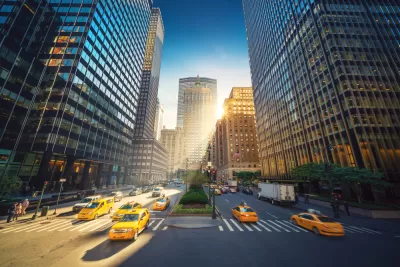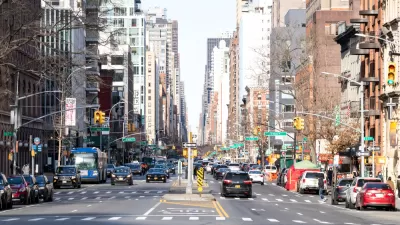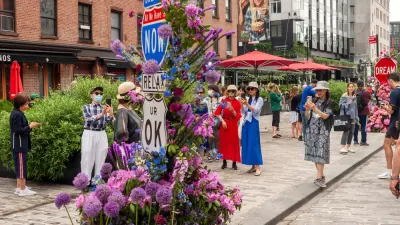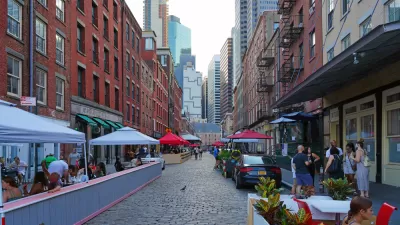The debate about whether the pedestrian-oriented changes made to the New York City streetscape during the pandemic should be permanent has a high-profile battleground on Park Avenue.

John Surico writes about a planning opportunity that could restore the median of Park Avenue in Manhattan to its former prominence as a pedestrian promenade.
"It has been a long time, but once it was possible and even fashionable to take a stroll through a far different Park Avenue, one with a green swath of lush lawn and shrubbery nearly 40 feet wide. It was the city’s first linear park, where pedestrians took precedence over cars and there were plenty of benches to take a break," according to Surico.
A project to repair an underground, "cavernous" shed used by Metro-North commuter trains traveling in and out of Grand Central Station also offers an opportunity to "transform Park Avenue’s malls and restore them to their original splendor," reports Surico.
"The work requires ripping up nearly a dozen streets along Park Avenue, from East 46th to East 57th Streets, making possible a new vision for that stretch of the thoroughfare."
"Among the options the city is considering is bringing back chairs and benches, along with more ambitious ideas like expanding the median, eliminating traffic lanes and carving out room for bike lanes and walking paths."
The Park Avenue project is just one example of an ongoing, citywide debate about whether the pandemic offered a chance to permanently rethink the city's streets, providing more space for pedestrians and people on bikes instead of more and more cars. As with other examples around the city, "the removal of traffic lanes along Park Avenue is likely to elicit backlash from drivers who complain that the addition of pedestrian plazas and bike lanes across the city has made it increasingly difficult to get around," writes Surico. The city has already retreated from some of the open streets and bus priority plans crafted during the pandemic.
FULL STORY: New York City Wants to Bring More Park to Park Avenue

Trump Administration Could Effectively End Housing Voucher Program
Federal officials are eyeing major cuts to the Section 8 program that helps millions of low-income households pay rent.

Planetizen Federal Action Tracker
A weekly monitor of how Trump’s orders and actions are impacting planners and planning in America.

Ken Jennings Launches Transit Web Series
The Jeopardy champ wants you to ride public transit.

Crime Continues to Drop on Philly, San Francisco Transit Systems
SEPTA and BART both saw significant declines in violent crime in the first quarter of 2025.

How South LA Green Spaces Power Community Health and Hope
Green spaces like South L.A. Wetlands Park are helping South Los Angeles residents promote healthy lifestyles, build community, and advocate for improvements that reflect local needs in historically underserved neighborhoods.

Sacramento Plans ‘Quick-Build’ Road Safety Projects
The city wants to accelerate small-scale safety improvements that use low-cost equipment to make an impact at dangerous intersections.
Urban Design for Planners 1: Software Tools
This six-course series explores essential urban design concepts using open source software and equips planners with the tools they need to participate fully in the urban design process.
Planning for Universal Design
Learn the tools for implementing Universal Design in planning regulations.
Heyer Gruel & Associates PA
Ada County Highway District
Institute for Housing and Urban Development Studies (IHS)
City of Grandview
Harvard GSD Executive Education
Toledo-Lucas County Plan Commissions
Salt Lake City
NYU Wagner Graduate School of Public Service





























